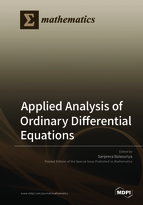Applied Analysis of Ordinary Differential Equations 2018
A special issue of Mathematics (ISSN 2227-7390).
Deadline for manuscript submissions: closed (31 October 2018) | Viewed by 20248
Special Issue Editor
Interests: applied analysis and modeling; nonlinear dynamics; ordinary differential equations; chaotic mixing; nonautonomous systems; stochastic differential equations; fluid dynamics; geophysical fluid dynamics; microfluidics; combustion; biology of growth (tissues, yeast, cells, invasive species); data-driven modeling
Special Issues, Collections and Topics in MDPI journals
Special Issue Information
Dear Colleagues,
One might say that ordinary differential equations (notably in Isaac Newton’s analysis of the motion of celestial bodies) had a central role in the development of modern applied mathematics. This special issue is devoted to research articles which build on this spirit: combining analysis with applications of ordinary differential equations (ODEs).
ODEs arise across a spectrum of applications in physics, engineering, geophysics, biology, chemistry, economics, etc., because the rules governing the time-variation of relevant fields is often naturally expressed in terms of relationships between rates-of-change. ODEs also emerge in stochastic models—for example when considering the evolution of a probability density function—and in large networks of interconnected agents. The increasing ease of numerically simulating large systems of ODEs has resulted in a plethora of publications in this area; nevertheless, the difficulty of parametrizing models means that computational results by themselves are sometimes questionable. Therefore, analysis cannot be ignored.
This Special Issue solicits articles that possess both the following features: interesting applications, and mathematical analysis driven by such applications. Novel and innovative applications of ODEs are particularly welcome, as are unconventional ways of using rigorous mathematics to obtain intuition in applications.
Prof. Dr. Sanjeeva Balasuriya
Guest Editor
Manuscript Submission Information
Manuscripts should be submitted online at www.mdpi.com by registering and logging in to this website. Once you are registered, click here to go to the submission form. Manuscripts can be submitted until the deadline. All submissions that pass pre-check are peer-reviewed. Accepted papers will be published continuously in the journal (as soon as accepted) and will be listed together on the special issue website. Research articles, review articles as well as short communications are invited. For planned papers, a title and short abstract (about 100 words) can be sent to the Editorial Office for announcement on this website.
Submitted manuscripts should not have been published previously, nor be under consideration for publication elsewhere (except conference proceedings papers). All manuscripts are thoroughly refereed through a single-blind peer-review process. A guide for authors and other relevant information for submission of manuscripts is available on the Instructions for Authors page. Mathematics is an international peer-reviewed open access semimonthly journal published by MDPI.
Please visit the Instructions for Authors page before submitting a manuscript. The Article Processing Charge (APC) for publication in this open access journal is 2600 CHF (Swiss Francs). Submitted papers should be well formatted and use good English. Authors may use MDPI's English editing service prior to publication or during author revisions.
Keywords
- ordinary differential equations
- dynamical systems
- applied analysis
- regular and singular perturbations
- asymptotic analysis
- multiple time scales
- stability of solutions
- bifurcations
- resonance
- chaos
- attractors
- boundary value problems
- spectral theory
- control theory
- stochastic ordinary differential equations
- impulsive differential equations
- fractional differential equations
- differential equations on lattices/networks






